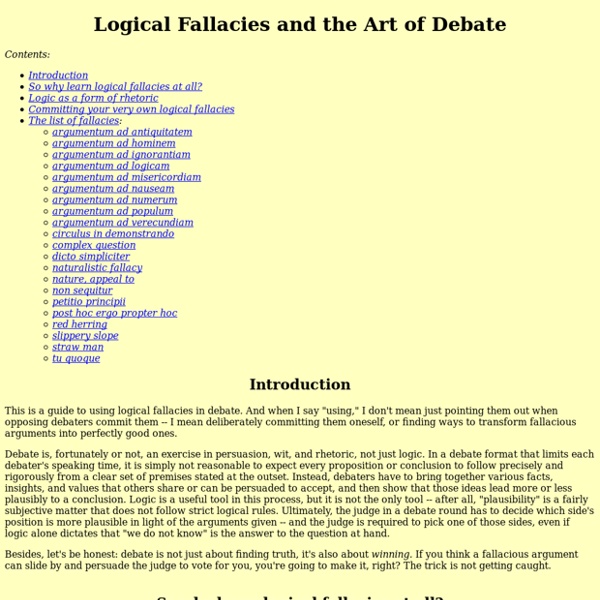Logical Fallacies: The Fallacy Files
A List Of Fallacious Arguments
attacking the person instead of attacking his argument. For example, "Von Daniken's books about ancient astronauts are worthless because he is a convicted forger and embezzler." (Which is true, but that's not why they're worthless.) Turing thinks machines think. (Note the equivocation in the use of the word "lies".)
English Composition 1: Rational Appeal
Logos, along with ethos and pathos, make up a means of persuasion called the three appeals — three ways of persuading an audience (Covino and Jolliffe 15). Logos translates as "word" or "reason," and in rhetoric, logos refers to different systems of reasoning, working together to persuade an audience. Logos, pathos, and ethos are different but complementary methods of persuasion. Ethos moves an audience by proving the credibility and trustworthiness of the rhetor, pathos seeks to change the attitudes and actions of the audience by playing to the emotions of the audience, and logos persuades through the powers of reasoning (Covino and Jolliffe 17). Developing Logos For the ancient Greeks, logos meant more than logic or reasoning alone: it meant "thought plus action" (Covino and Jolliffe 17), "thought" being the ideas themselves and "action" being the way in which those ideas are presented to the audience.
Cliche List — The Best Thing Since Sliced Bread
How to Disagree
March 2008 The web is turning writing into a conversation. Twenty years ago, writers wrote and readers read. Many who respond to something disagree with it. The result is there's a lot more disagreeing going on, especially measured by the word. If we're all going to be disagreeing more, we should be careful to do it well. DH0. This is the lowest form of disagreement, and probably also the most common. u r a fag!!!!!!!!!! But it's important to realize that more articulate name-calling has just as little weight. The author is a self-important dilettante. is really nothing more than a pretentious version of "u r a fag." DH1. An ad hominem attack is not quite as weak as mere name-calling. Of course he would say that. This wouldn't refute the author's argument, but it may at least be relevant to the case. Saying that an author lacks the authority to write about a topic is a variant of ad hominem—and a particularly useless sort, because good ideas often come from outsiders. DH2. DH3. DH4. DH5.
15 Logical Fallacies You Should Know Before Getting Into a Debate - TheBestSchools.org
Logical fallacies are flawed, deceptive, or false arguments that can be proven wrong with reasoning. These are the most common fallacies you should know about. Arguments and debates are an important part of college and academic discourse. But not every argument is perfect. You'll hear logical fallacies in the classroom, during televised debates, and in arguments with your friends. This article lays out some of the most common logical fallacies and how to identify them. What Is a Logical Fallacy? Logical fallacies are flawed, deceptive, or false arguments that can be proven wrong with reasoning. A formal fallacy is an argument with a premise and conclusion that doesn't hold up to scrutiny.An informal fallacy is an error in the form, content, or context of the argument. — Ad Hominem An ad hominem fallacy uses personal attacks rather than logic. Ad hominem arguments are often used in politics, where they are often called "mudslinging." Study Tool — Straw Man straw man argument — Appeal to Ignorance
Eliminating Wordiness | Undergraduate Writing Center
In concise writing words pull their own weight. Each carries meaning essential to the content of the sentence. Try to identify which words add meaning to the sentence and which just take up space. As you revise your work, keep these enemies of concision in mind. 1. Weak words Some words are the written equivalent of “um.” Generally speaking writers can kind of rely on certain online indexes of journals to basically start their research. The words in boldface have little to do with the point of the sentence; they can go. 2. We’re used to seeing some words paired: each and every, true and accurate, full and complete. The end result was brighter in color than we had hoped, but we plan to repaint the wall in the future . This sentence only needs the italicized words, not the bold ones: The result was brighter than we had hoped, but we plan to repaint the wall. 3. If you can think of one word to replace several, use the word. Pared down, the sentence reads like this: 4. 5. 6. 7. 8.
The Skeptics' Guide To The Universe - Logical Fallacies
Structure of a Logical Argument Whether we are consciously aware of it or not, our arguments all follow a certain basic structure. They begin with one or more premises, which are facts that the argument takes for granted as the starting point. Then a principle of logic is applied in order to come to a conclusion. Premise1: If A = B, Premise2: and B = C Logical connection: Then (apply principle of equivalence) Conclusion: A = C In order for an argument to be considered valid the logical form of the argument must work – must be valid. Also it is important to note that an argument may use wrong information, or faulty logic to reach a conclusion that happens to be true. Breaking down an argument into its components is a very useful exercise, for it enables us to examine both our own arguments and those of others and critically analyze them for validity. Examine your Premises As stated above, in order for an argument to be sound all of its premises must be true.



